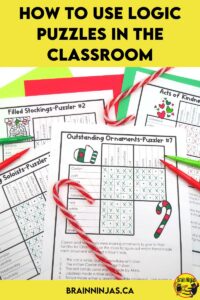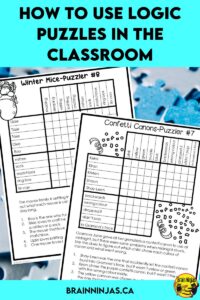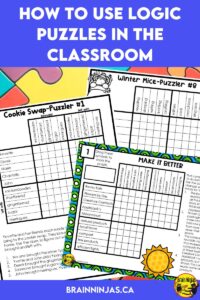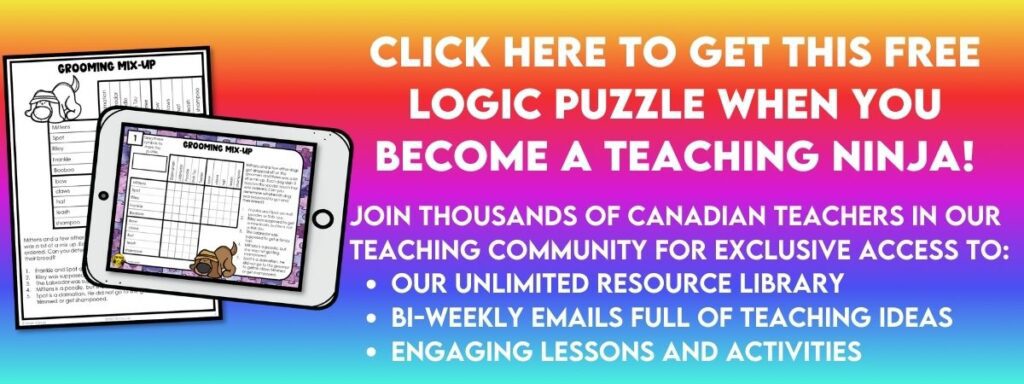
Logic puzzles are a series of written clues that readers use to fill in a chart. The chart shows which items match each other. These types of puzzles have been a life-long favourite and come in a variety of levels of difficulty. We created puzzles for our students to solve for fun, but have also looked at how solving logic puzzles helps students become better readers. Read on to learn the ways you can use logic puzzles in your classroom to help teach reading.
How to Solve Logic Puzzles
If you’ve never solved a logic puzzle, it can be a little daunting. Solvers use a dot for any clue that is correct and an x for any clue that is incorrect. There can only be one correct choice in each row or column within each box.
While solving the puzzle you may need to reread clues or return to them later when more of the puzzle is solved. The clues are not always in the order needed to solve the puzzle.
We found this great video which goes through solving a puzzle. Once you get started, you’ll love them too.
Reading for Information in Logic Puzzles

Each clue in a logic puzzle has information in them. One strategy we use is underlining important words (like the clues in the chart). This helps students identify the parts of the sentence that are important for the clue. It also helps students identify parts of the sentence that are not in use yet.
Knowing the difference between important information and information that is superfluous is an important skill when doing research or when answering questions with evidence. Many students cannot locate the most specific information and include too much (or not enough).
When reading for information in puzzles, students can break down the sentences into smaller bits of information as they solve the puzzle.
Some of the clues in puzzles require students to put the information in order or make sense of it before they can apply it to the chart. For example, some clues might say “Ben arrived before Jan but after Sean.” Students need to understand that the order the people arrived was Sean, Ben and then Jan.
Usually, logic puzzles are designed so that the solver doesn’t need any outside information. Students will need to make inferences based on the clues. For example, if Jan doesn’t like chocolate and the choices are popcorn or a box of chocolates, you can deduce that she chose the popcorn.
Puzzles help with tracking. This is especially true because with logic puzzles solvers track between the chart and the clues. Demonstrate this for students by modelling how to solve the puzzles.
Problem Solving and Critical Thinking

Like all puzzles, solvers need to have the perseverance to work through the difficulties. In our experience, students who can work through a puzzle until the end are more likely to be able to work independently, will have more confidence in taking on challenging tasks, and are more likely to take initiative for their own learning.
Problem solving is one skill that is important for a growth mindset. Students need to know how to approach problems. Skills used to solve puzzles can be transferred to a variety of situations. Puzzles help teach students to read through all the available information to gather clues about how to proceed.
If you’re looking for more ideas on how to build a growth mindset with your class, check out our post Use the Learning Pit to Teach Growth Mindset.
Puzzles are Good for the Brain

Puzzles are always good for helping the brain use its short-term memory, improve mental speed and reinforce connections between brain cells. Solving a puzzle releases dopamine in the brain, which gives the solver a sensation of success. Solving puzzles helps with concentration. They exercise parts of the brain that aren’t always used on a daily basis.
Doing a puzzle first thing in the morning makes for a great bell ringer. Leave a puzzle on each of your students’ desks so they can get started right away. Learn more about how to use bell ringers in our post Saved by the Bell Ringers in Upper Elementary.
What is More Fun Than a Logic Puzzle?
Let’s be honest! Logic puzzles are fun. They are a great tool during your transitions. Once your students know how to solve them, use them with your early finishers. Leave a set in a folder where your students can access them on their own. Have a few different ones available each week so students can work on them in between other activities.
Puzzles are a great way to engage reluctant readers. If it doesn’t feel like work, your students might be more interested. Find more strategies in our post Practical Strategies for Reluctant Readers.
Where to Find Logic Puzzles

We have created lots of different sets. Most of our sets involve different holidays. Each set includes a paper version as well as a Google Slides version.
Our logic puzzle bundle includes all our sets. Find it in our TPT Store or our BN Shop.
Fall Puzzles (10 puzzles) in our TPT Store or our BN Shop.
Back to School Puzzles (20 puzzles) in our TPT Store or our BN Shop. You can try a free sample from this set in our TPT Store or our BN Shop.
Halloween Puzzles (15 puzzles) in our TPT Store or our BN Shop.
Winter Puzzles (10 puzzles) in our TPT Store or our BN Shop.
Christmas Puzzles (10 puzzles) in our TPT Store or our BN Shop.
New Year’s Puzzles (10 puzzles) in our TPT Store or our BN Shop.
Lunar New Year Puzzles (10 puzzles) in our TPT Store or our BN Shop.
Valentine’s Day Puzzles (10 puzzles) in our TPT Store or our BN Shop.
St. Patrick’s Day Puzzles (10 puzzles) in our TPT Store or our BN Shop.
Spring Puzzles (10 puzzles) in our TPT Store or our BN Shop.
Easter Puzzles (11 puzzles) in our TPT Store or our BN Shop.
Earth Day Puzzles (10 puzzles) in our TPT Store or our BN Shop.
End of the Year Puzzles (15 puzzles) in our TPT Store or our BN Shop.
Other Puzzles We Have Created
Christmas Word Puzzles, Logic Puzzles and Writing Prompts is a collection of different word games. It is not included in the logic puzzle bundle. Find it in our TPT Store or our BN Shop. Winter Word Games, Puzzles and Writing Prompts does not reference Christmas at all. Find it in our TPT Store or our BN Shop. You can try a free sample from both of these sets in our TPT Store or our BN Shop.
Would you like to try one of our logic puzzles for free? We created one just for you. We can send it to your inbox when you sign up for our email list. If you’re already on the list, you can find the puzzle in our Resource Library.
Why Do You Enjoy Logic Puzzles?
Some people enjoy puzzles more than others. If you enjoy logic puzzles, tell us where you love to find them. We’re always looking for more.







